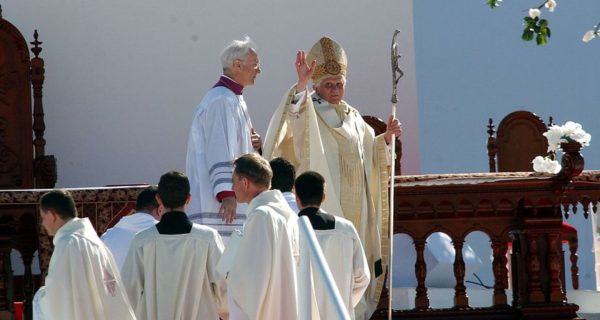The great deal of discussion surrounding the resignation of His Holiness[1] Benedict XVI has led to observations of clerical dress, most notably the vestments worn during Mass. What some may not know is that many separate items of the priestly vestments are derived from Roman court wear, and more generally, from secular clothing of classic antiquity.[2] For example, the stole is thought to be derived from the scarf of office among Imperial officials in the Roman Empire.[3] [4] [5] As members of the clergy became members of the Roman administration they were granted certain honors,[6] one specifically being a designator of rank within the imperial (and ecclesiastical) hierarchy.
On the topic of Romans and clergy, the Patriarchate of Constantinople is the last official Roman office in existence, having never ceased to exist since its establishment 1,700 years ago by Constantine the Great (in keeping with his granting of honours). It could technically be said that the Roman Empire has not yet completely disappeared. The Siege of Constantinople in 1453 is normally cited as the definitive end-point of the Roman Empire (if not the Fall of Rome in 476).
In fact, the Siege was quite a spectacle and the intersection of many peculiar events and people. One particularly strange (and obscure) character was the Scottish engineer by the name of Johannes (John) Grant.[7] Grant, who was also an adventurer, had simply wandered through Germany and joined up with Giovanni Giustiniani. Giustiniani, a Genoese captain, was leading his company of 700 professional soldiers to the defense of Constantinople. At the siege, the Turks, under Sultan Mehmet II, had tried non-stop to tunnel under the walls of Constantinople. Grant was successful in preventing those tunnels by his counter-mining operations. He would find the enemy tunnels, dig a tunnel underneath or next to it, break through, and then burn the supporting beams thereby causing a collapse. The Turks did not succeed in any of their tunnels due to Grant’s efforts.[8] [9] The Turks did, of course, succeed in the grand scheme of things and eventually became one of the largest empires ever known.
The Ottoman Empire had many “characters” throughout its history, but easily one of the most unexpected is that of Wojciech Bobowski. Bobowski (1610-1675) was a Polish musician and dragoman in the Ottoman Empire, who was, at a young age, captured by Crimean Tatars and, due to his musical training, sold to the court of Sultan Murad IV.[10] He was later freed, and subsequently worked in Constantinople as an interpreter. It seems that Ali Ufki, as Bobowski was called after his conversion to Islam, was wholly integrated into Ottoman society. He played a role in introducing Genevan psalms in the Empire and, due to such introduction, also had an effect on Turkish music theory.[11] Ufki translated the Anglican catechism into Ottoman Turkish, wrote an explanation of Islam in Latin, and translated the Bible into Ottoman Turkish.[12] A modernized version of Ufki’s Bible translation is still in use among Turkish-speaking Christians today.[13] Ufki, known by his pen-name “Albertus Bobovius,”[14] also wrote a grammar of the Turkish language in 1666. Ufki, though a Muslim at death, did express (circumspectly, given the death penalty for apostasy) a desire to return to the Christian faith by requesting a job working as an interpreter in Charles II’s court.[15]
One final thought given the mention of linguistics and Christianity. St. Francis Xavier is well known for his missionary work in Asia, but he is much less known for his work in linguistics. In his extensive travels and interactions in Asia, he encountered many languages. He is known for his insistence that a missionary should adapt to the culture of the people they evangelize and to learn language of said people[16] (giving rise to the term “missionary linguistics”). He was one of the earliest individuals to note commonalities between languages, mainly in word roots.
[1] Benedict can still be styled as “His Holiness,” despite now being pope emeritus.
[2] McCloud, Henry J., Clerical Dress and Insignia of the Roman Catholic Church (Milwaukee: Bruce Pub. Co, 1948), p. vii
[3] Kunzler, Michael, The Church’s Liturgy (New York: Continuum, 2001), p. 131
[4] Planche, J. R., A Cyclopedia Of Costume: Vol. II A General History Of Costume In Europe (London: Chatto and Windus, 1879), p. 42
[5] Hedley, John, The Holy Eucharist (London: Longmans, Green, and Co., 1911), p. 209
[6] Gerberding, R., Medieval Worlds (New York: Houghton Mifflin Company, 2004), pp. 55-56
[7] Runciman, Steven, The Fall of Constantinople 1453 (Cambridge: Cambridge University Press, 1990), p. 84
[8] Crowley, Roger, 1453: the holy war for Constantinople and the clash of Islam and the West, (New York: Hyperion, 2005). pp. 168–171
[9] Nicol, Donald M., The Last Centuries of Byzantium, 1261-1453, (Cambridge: Cambridge University Press, 1993), p. 379
[10] Neudecker, Hannah, ‘Wojciech Bobowski and his Turkish Grammar (1666): A Dragoman and Musician at the Court of Sultan Mehmed IV,’ Dutch Studies published by NELL [Near Eastern Languages and Literatures Foundation, Leiden] 2 (1996)
[11] Trocmé-Latter, Daniel. “Der Genfer Psalter in den Niederlanden, Deutschland, England und dem Osmanischen Reich (16.–18. Jahrhundert). By Judith I. Haug.” Music and Letters 93.1 (2012): 138-140, p. 140
[12] Privratsky, Bruce G., “A History of Turkish Bible Translations” – March 2011 – Version G
<http://historyofturkishbible.files.wordpress.com/2011/03/turkish-bible-chronology-privratsky-march-2011-ver-g.pdf>
[13] Faroqhi, Suraiya, Subjects of the Sultan: Culture and Daily Life in the Ottoman Empire, (London: I.B. Tauris, 2005), p. 93
[14] Privratsky, 19
[15] Privratsky, 131
[16] Doniger, Wendy, ed. Merriam-Webster’s encyclopedia of world religions. Merriam Webster, 1999.
